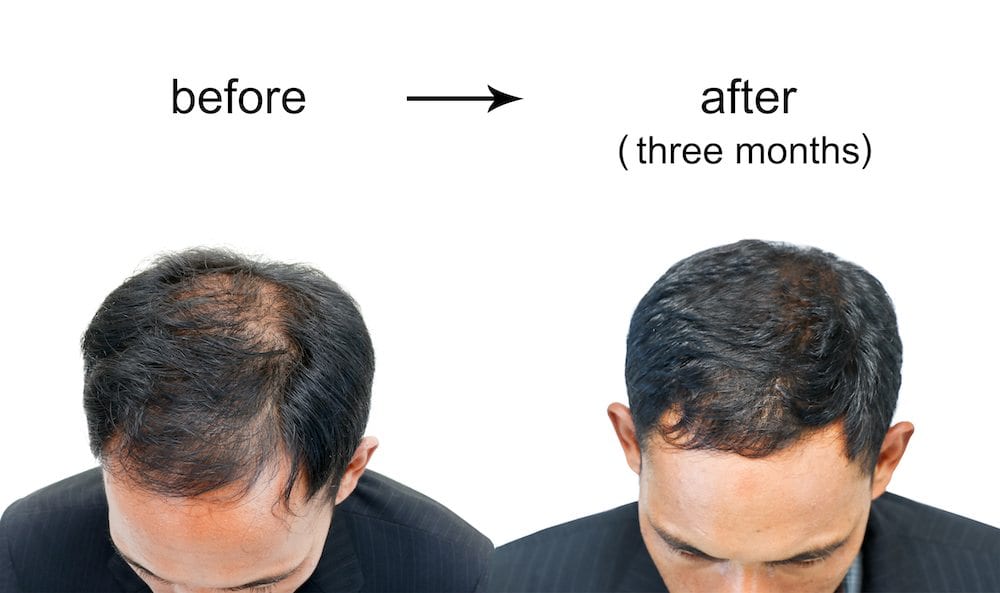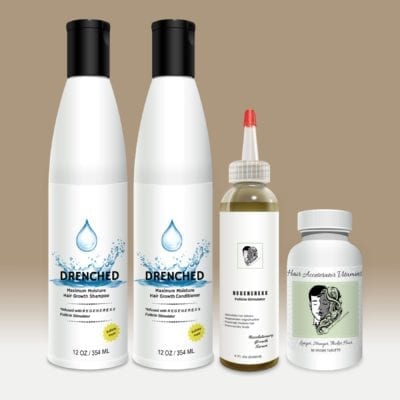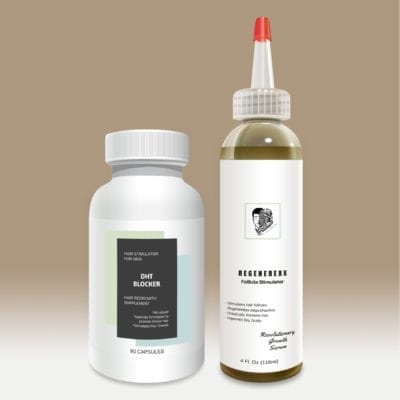Androgenic alopecia, known colloquially as Male Pattern Baldness, is a type of hair loss estimated to affect more than 50 million men in the United States. Male Pattern Baldness tends to start above the temples and continues to the top of the head to generate the typical “M” shape. Over time and without aggressive treatment to combat it, this type of hair loss can lead to complete baldness. While the exact cause of Male Pattern Baldness is unknown, it seems to be linked to a genetic predisposition combined with elevated levels of one specific sex hormone, dihydrotestosteron (DHT). High levels of DHT at the hair follicles leads to miniaturization – a process by which the growth phase of hair natural cycle is shortened and new growth is delayed. Although hair follicles don’t necessarily die, over time follicles may stop growing new hair all together.
There are two common treatments for Male Pattern Baldness, one available over the counter and the other, a drug available with your doctor’s prescription. While both options are considered popular treatments, neither is a natural solution and both have considerable side effects – including a decreased libido/sex drive. Such side effects may be more than you, or your partner for that matter, may be willing to take on for the sake of keeping your hair. But there are other safer, effective yet natural options available. Continue reading to learn more about treatments for Male Pattern Baldness and how you may be able to reverse it naturally!
Two Common Treatments (the unnatural route)
- Minoxidl (Rogaine)
- Finastiride (Propecia)
Of the available options for treating Male Pattern Baldness, Minoxidil and Finastidine are two fairly common options.
Minoxidili, marketed under the brand name Rogaine, is a topical formula that is applied directly to the scalp in order to stimulate hair follicles. This FDA approved treatment for Male Pattern Baldness is designed to slow the hair loss process but it is not without side effects that are worth taking into consideration.
Side effects: What is probably the most upsetting effect of Minoxidil isn’t one related to using the product, but rather is a consequence of ceasing to use it. Minoxidil users consistently report experiencing hair loss when then they stop using Minoxidil, and for some, the hair loss returns with a vengeance! Sure, stopping hair loss is importance aspect of overall hair health and self confidence, but who wants to be tied to a product forever? In addition to this, other common side effects include itching, swelling, burning and inflammation.
Finasteride, marketed under the brand name Propecia, is an oral prescription drug from pharmaceutical giant Merck, and a common baldness treatment that is thought to be more effective than Mixodil at stopping hair loss. Finasteride works by binding to 5-alpha reductase, the enzyme responsible for converting free floating testosterone into DHT.
Side effects: Some of the side effects reported with Finasteride include cold sweats, dizziness, weight gain, hives and swelling of the legs , arms and face. While troubling, perhaps even more frightening for some are the issues with erectile dysfunction and decreased libido reported by users of the drug. For some the drug is well tolerated for years before such adverse effects are experienced, and for others, the onset of intermittent decline in sex drive is more immediate. Either way, this potential side effect is something that needs to be discussed more frequently and openly so that people have a better understanding of the risks they’re undertaking by pursuing a particular treatment.
For these and other reasons, natural treatment solutions are increasing in popularity as an effective option for treating Male Pattern Baldness. Below are the three effective, natural options
1. DHT Blockers
By far the most popular natural option for safe yet highly effective treatments for Male Pattern Baldness is a DHT Blocker. Similar to the prescription drug discussed above, DHT Blockers work by arresting the 5-alpha reductase enzyme before it can convert testosterone into DHT – the metabolite thought to be responsible for hair loss. An effective DHT Blocker will not only slow or inhibit the conversion of 5-AR enzyme to DHT to reduce hair loss, but will also provide the biotin, and specific vitamins and minerals your hair needs to grow faster and fuller. Read more about this in this great article: DHT Blockers: the key to combating men’s hair loss?, and heavily consider utilizing a DHT Blocker to treat hair loss and regrow your hair.
2. Reset the Scalp and Reactivate Dormant Hair Follicles
Healthy hair starts at the scalp and new hair growth requires that your scalp be in optimum condition. To accelerate the hair growth process you’ll want to reduce dandruff, eliminate excessive itchiness or oiliness, address any potential scalp infections as well as stimulate dormant hair follicles. An effective product like Regenerexx Follicle Stimulator can help you achieve all of these goals. Regenerexx incorporates a proprietary blend of plant based botanicals whose anti-fungal and anti-inflammatory proprieties effectively increase circulation to the scalp and create an optimal foundation for hair growth. Use the follicle stimulator to reactivate dormant hair follicles and massage into the scalp in circular motions to encourage increased blood flow.
3. Incorporate power foods
Some of the suggestions here may seem cliché or unimportant, but you must not underestimate the tremendous role that nutritional imbalances play when it comes to hair loss. Poor diet can lead to both macro and micronutrient deficiencies that can compromise your health and encourage hair loss. To counteract the vitamin and mineral gaps that exist consider incorporate several power foods into your diet.
- Promote healthy hair by increasing your consumption of omega-3 fatty acids, typically found in fatty fish such as salmon and sardines.
- Make sure your diet is jam packed with red, yellow and orange fruits and vegetables which have plenty of beta carotene and vitamin A. Vitamin A promotes the development of healthy cells, including hair follicles, so you’ll want to have plenty of this in your diet.
- Eat foods that contain vitamin B7 (biotin) such as eggs, dairy products, fortified cereals and chicken
- Zinc deficiencies cause hair loss, so make sure you’re incorporating zinc rich foods into your diet as well.
- And of course, drink plenty of water daily to keep your hair healthy and growing!
By: Jessica Landry





